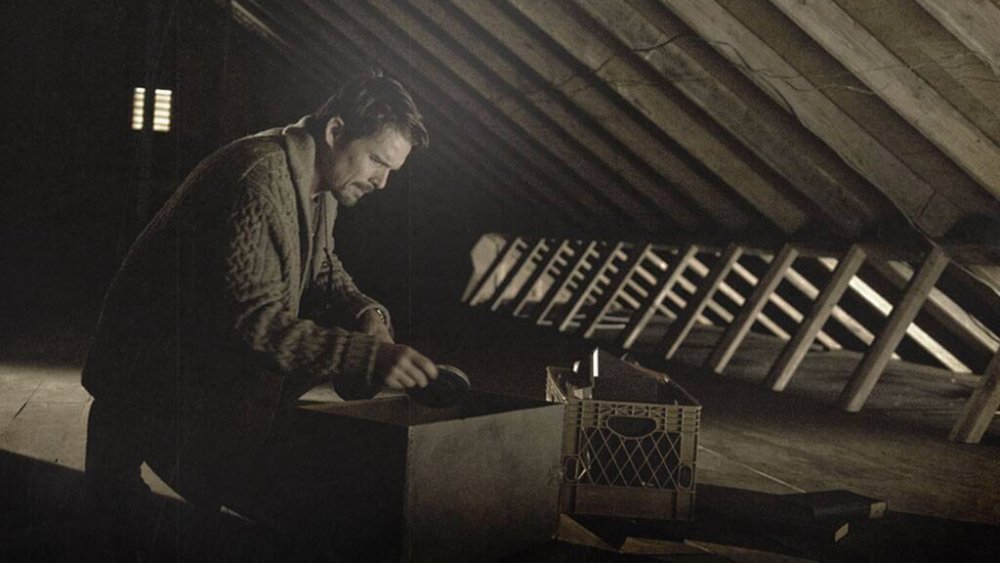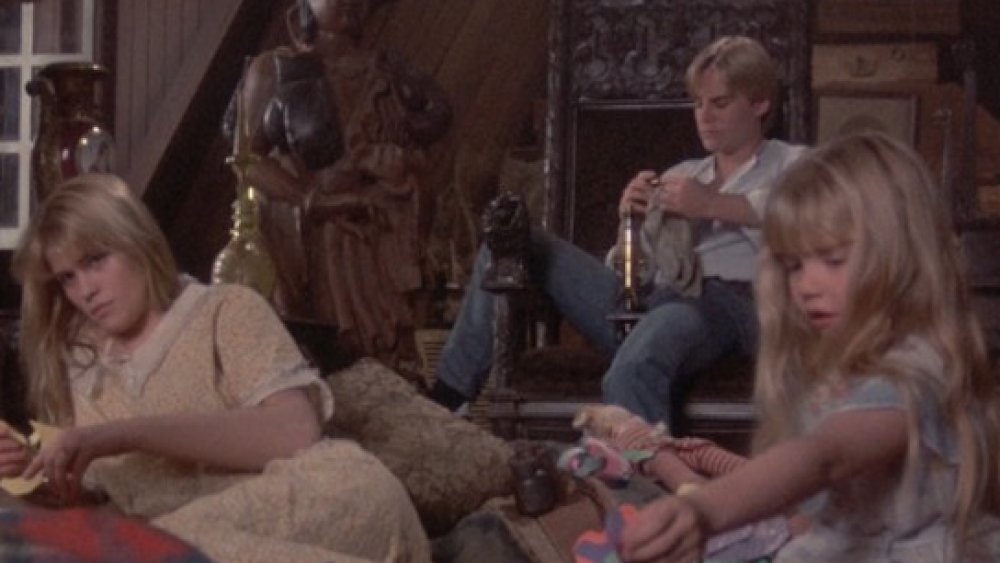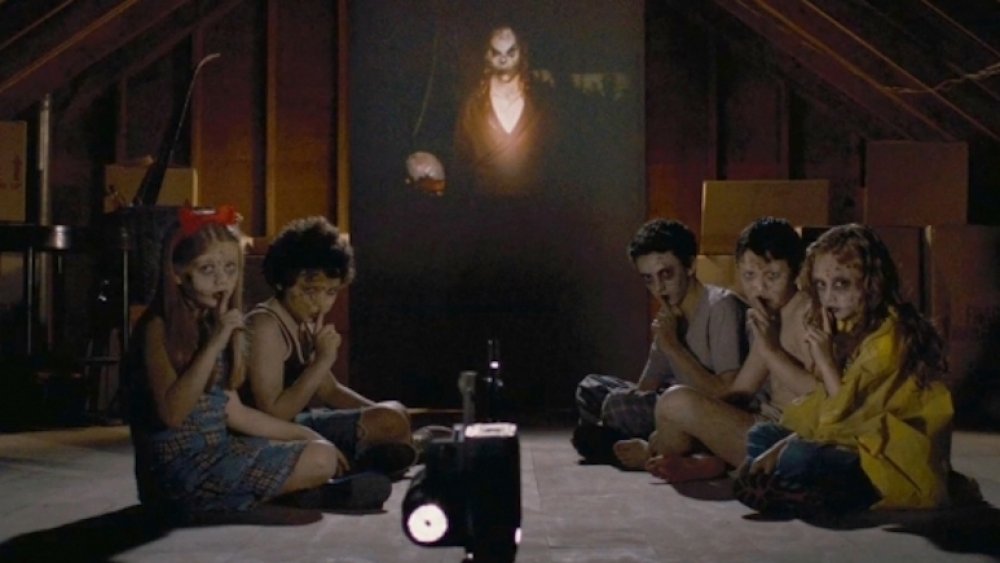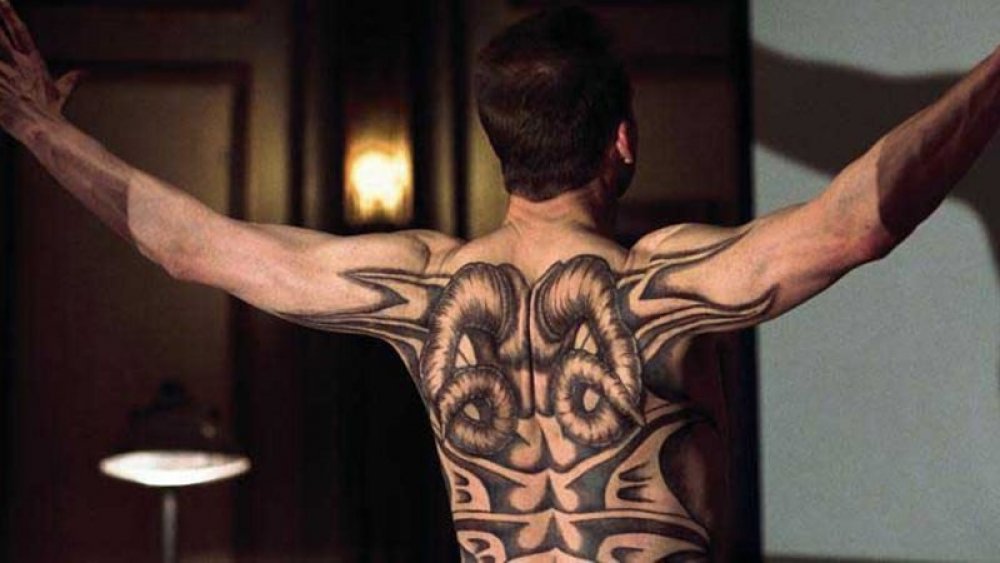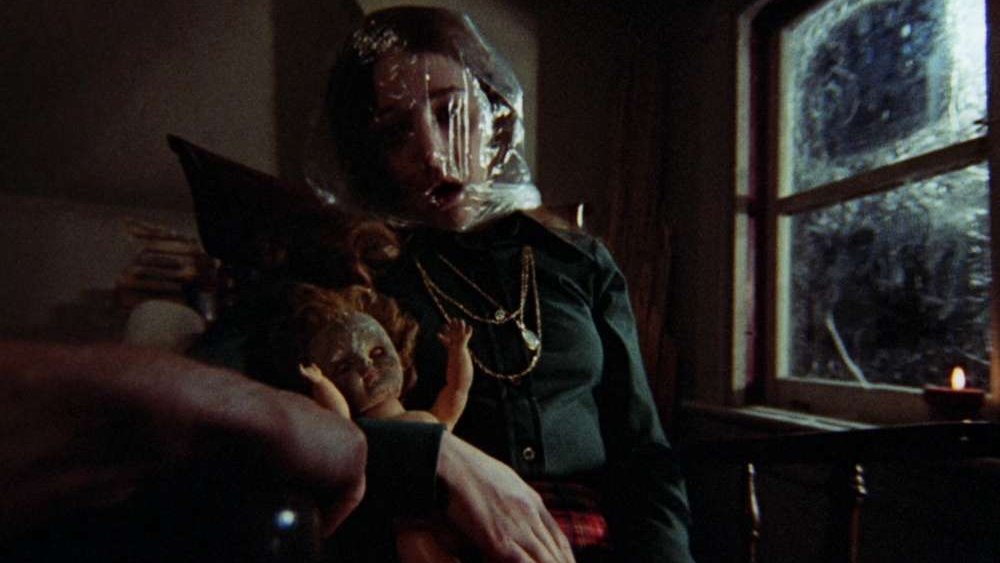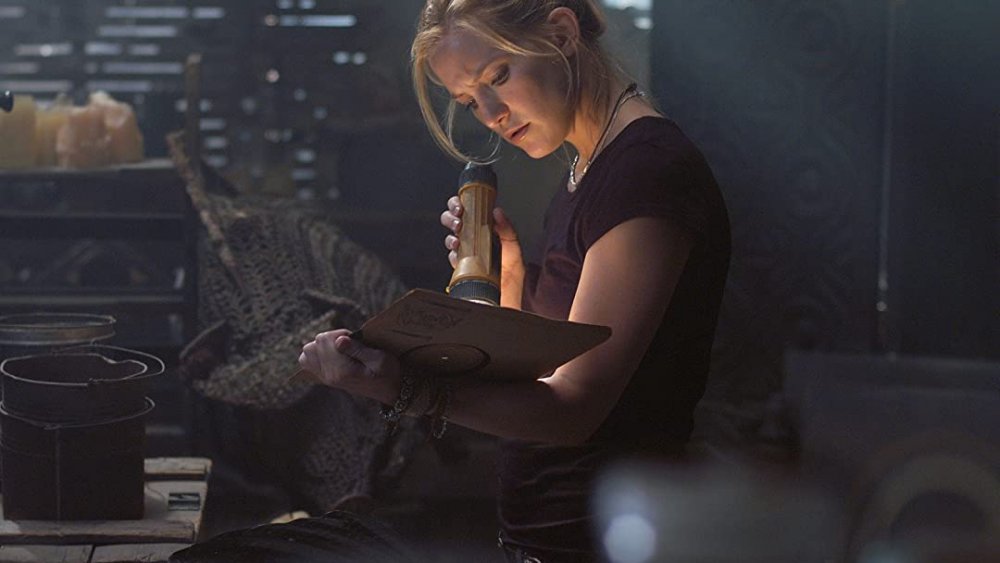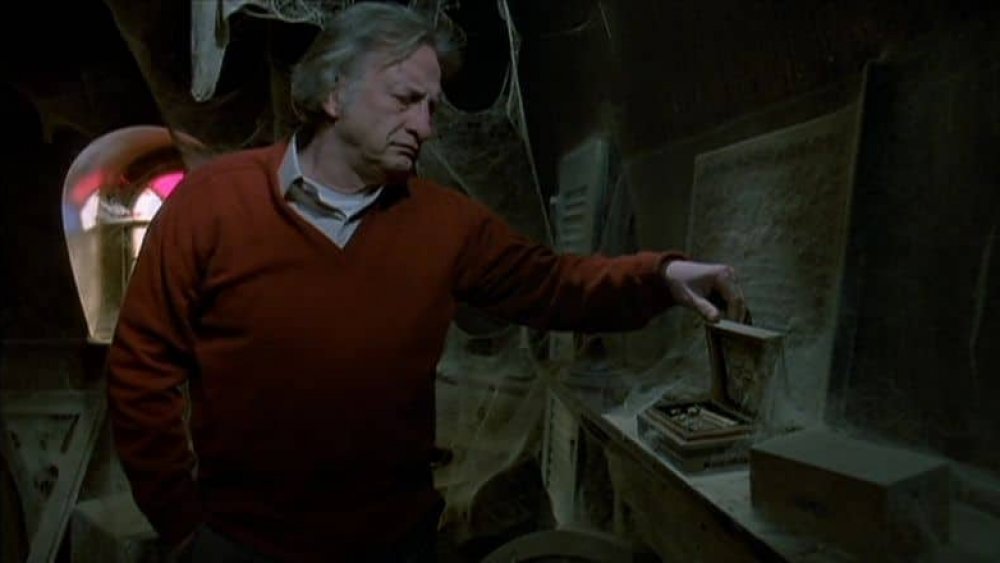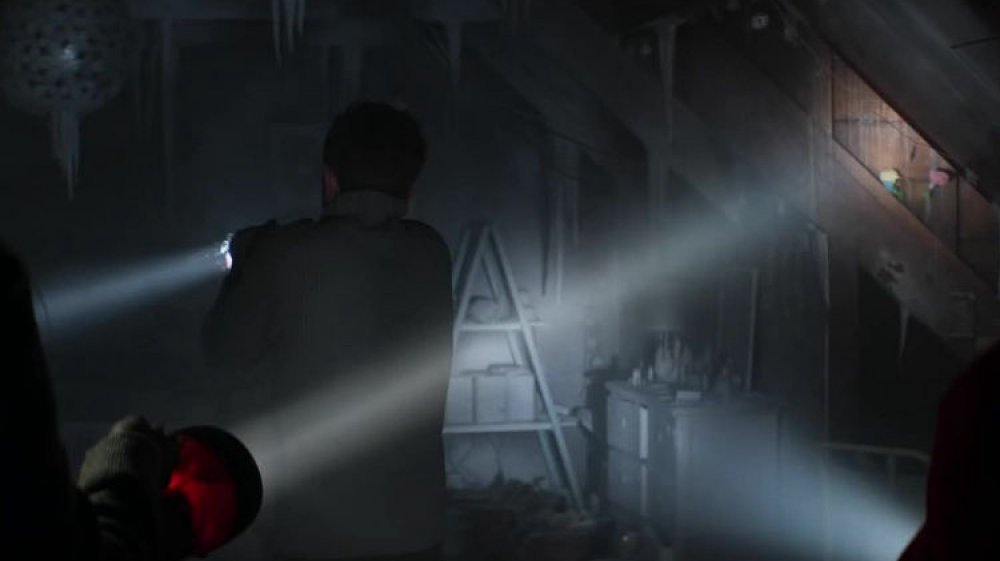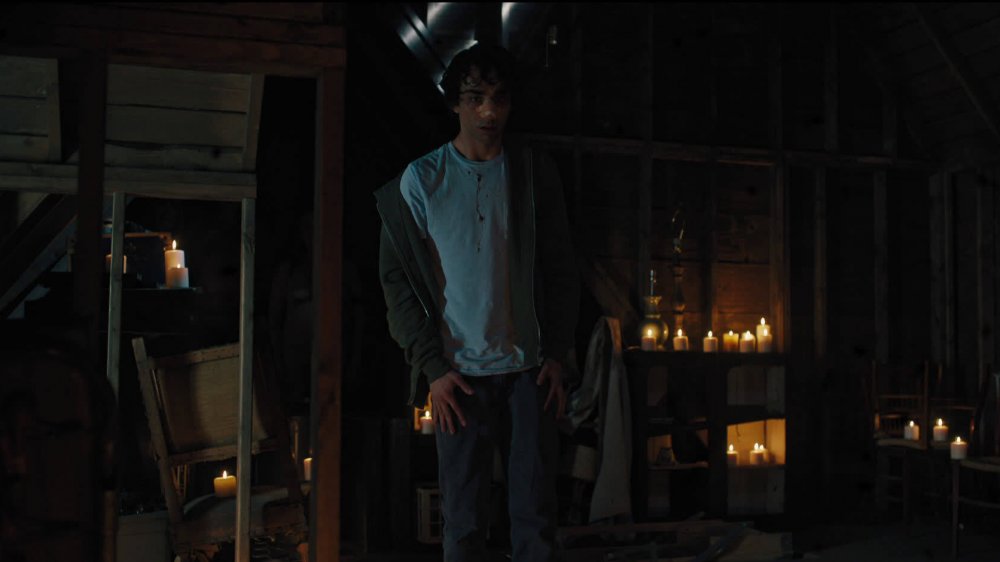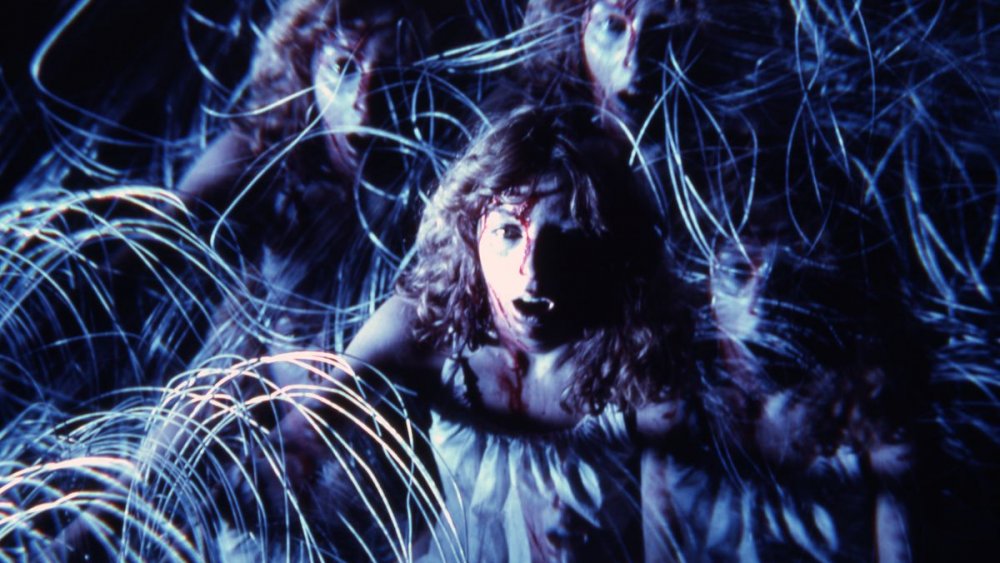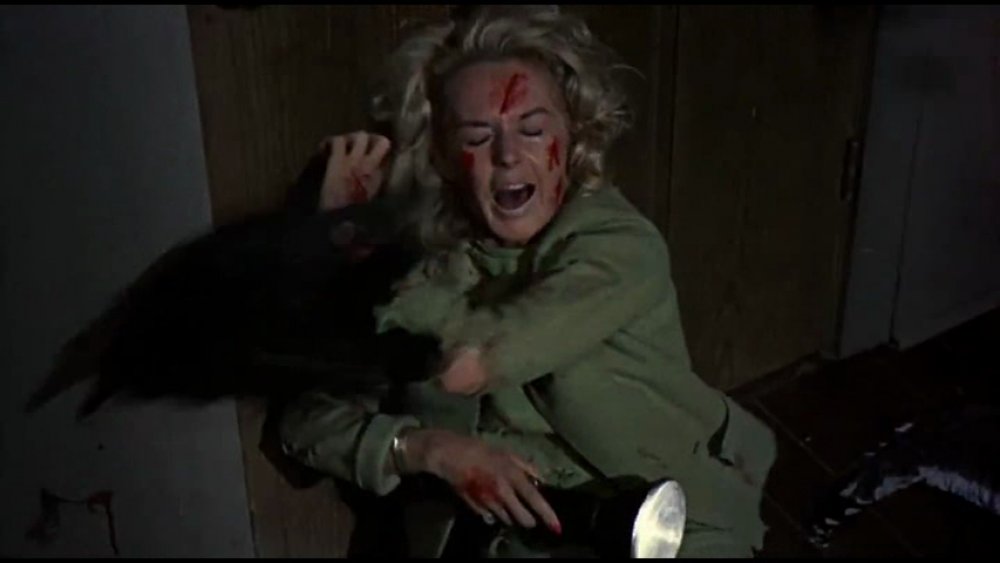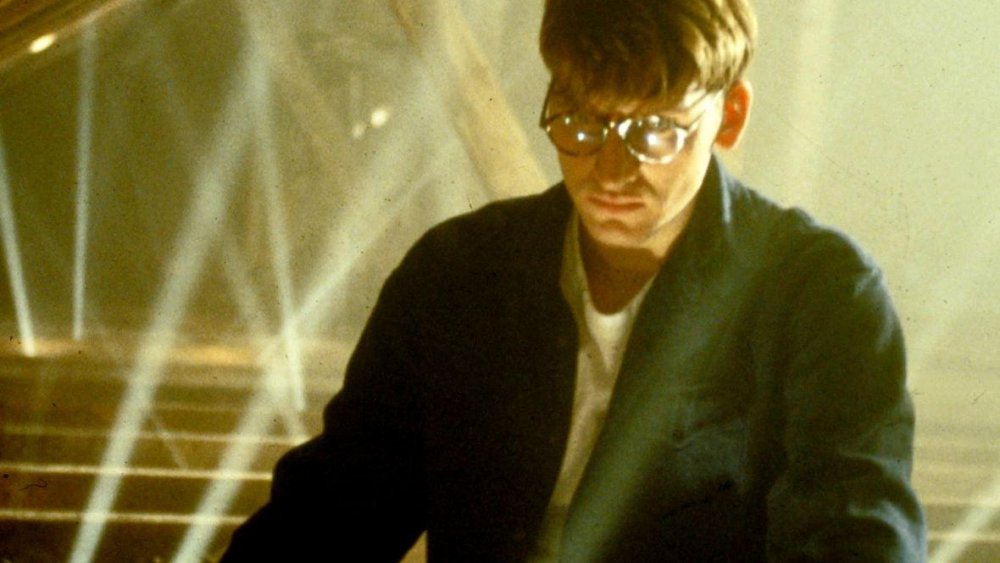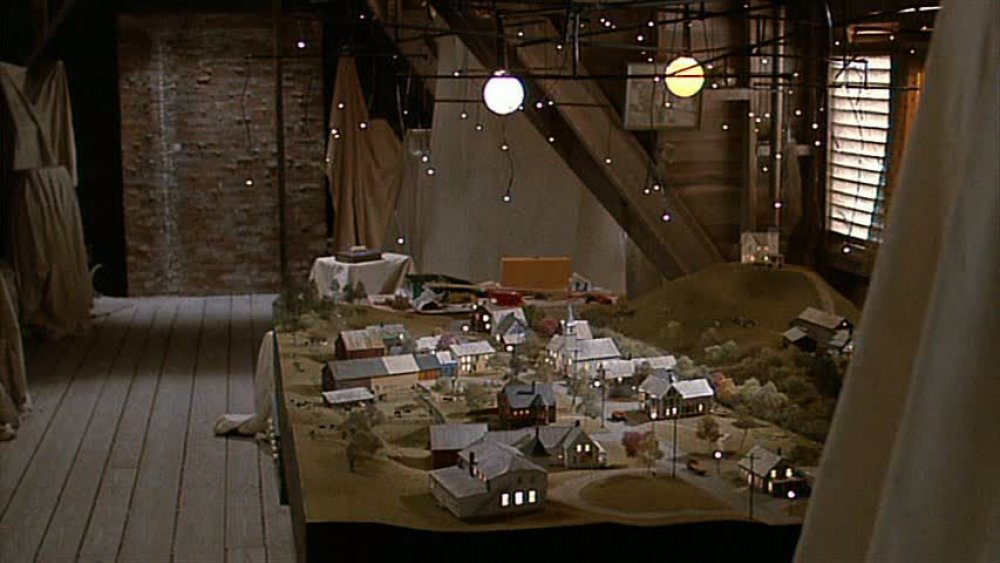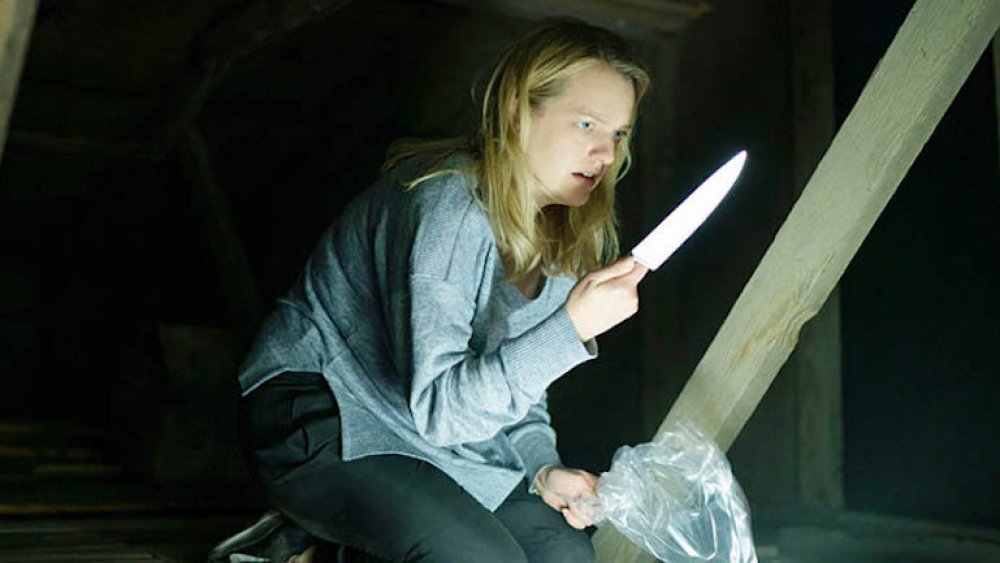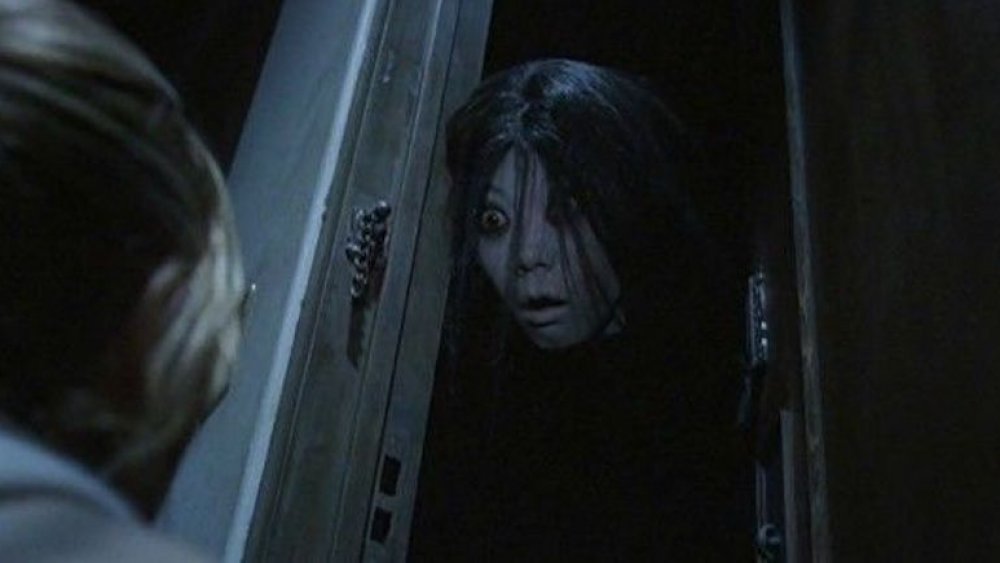The Creepiest Attics In Horror Movies
Much like basements, attics are liminal spaces in the home. Some are gorgeous, with great light and even better views. Lots of folks convert their attics into living or work spaces for this reason alone. But not all attics are created equal. Small, cramped spaces on the top floor that can be used for nothing but storage become really creepy, really fast. Worse, some attics even allow for surveillance of the floor directly below, which often ends up being the one containing bedrooms. This compromises the privacy of those living there ... often without their knowing.
No wonder horror movies love situating their terrifying tales in the attic. These films explore the full potential of these dusty, drafty spaces, which are often infrequently visited and filled with surprising (and sometimes life-threatening) things. They're a place to hide unwanted children, a site for demonic rituals, a home for vengeful ghosts, and sometimes just a space for mundane human evil. They're attics, as imagined by horror movies — and we're here to explore the creepiest ones around.
Flowers in the Attic
Based on V.C. Andrews' scandalous, incest-heavy gothic horror novel of the same name, 1987's Flowers in the Attic features what is arguably the creepiest attic ever put to screen. After the death of their beloved patriarch, the surviving Dollanganger family — Corinne, Cathy, Chris, Carrie and Cory — travel to Corinne's childhood home of Foxworth Hall to try and win over Corinne's estranged and extremely wealthy father. Expecting a warm welcome, the children are instead relegated to a little-used attic, where they are locked up until Corinne gets herself back into her father's will. Corinne's fanatical mother Olivia abuses the children mercilessly, until finally revealing that Corinne was cast out for marrying her uncle — their deceased father.
The children live in the attic for several years. Eventually, they discover their mother never planned to let them out at all, and has been feeding them arsenic in an attempt to secure her inheritance. This attic may feature a glorious view and be filled with all sorts of interesting things, but it becomes a prison, and, eventually, a grave for little Cory. The kids ultimately escape, but the trauma follows them for the rest of their lives. Lifetime adapted all four V.C. Andrews Flowers in the Attic books, but the 1987 film features the creepiest attic of them all.
Sinister
Scott Derrickson's chilling Sinister follows has-been true crime writer Ellison Oswalt as he explores a new book idea in an unconventional way: He moves his family into a home where a family was murdered in the backyard. Not long after setting up their new house, Ellison finds a box filled with film canisters in the otherwise empty attic. Upon watching these home movies, he discovers footage of multiple murders. The deaths of the family killed in the backyard are among them, but Ellison traces the footage to other crimes all over America involving families murdered by someone just off camera. Moreover, one child from each of these families have all gone missing, just after the recorded killings took place.
With the help of local law enforcement Deputy So-and-So (he gives himself this nickname, in the hopes of becoming part of Ellison's next book) as well as occult expert Professor Jonas, Ellison discovers the truth: A child-eating demon named Bughuul is responsible for these twisted murders. Each missing child watched the grotesque collection of home videos, became capable of being possessed by Bughuul, and committed the murders themselves. In a particularly terrifying scene, Ellison enters the attic ... only to find the missing children assembled there. This horrifying tale serves as a warning: Don't mess around with other people's things, even if you find them in what is now your own attic.
Red Dragon
In Brett Rattner's cinematic adaptation of Thomas Harris' first Hannibal Lecter novel, we meet Francis Dolarhyde, a vicious serial killer. Known as "The Tooth Fairy," Dolarhyde targets families and kills according to the lunar cycle. None of his murders take place in an attic, but an attic does play a major part in why he kills at all. As a child, Dolarhyde was brutally abused by his grandmother, a process that resulted in a violent split personality. Dolarhyde is obsessed with the William Blake painting The Great Red Dragon and the Woman Clothed in the Sun, which depicts a scene from the Book of Revelation. Each murder, Dolarhyde believes, brings him closer to becoming the beast depicted in the painting. He believes he hears the dragon's voice when he goes to the attic of his grandmother's house — a place that, relatedly, brings back memories of his childhood abuse. Thus, Dolarhyde's attic may not be where his crimes go down, but it's where the idea for them takes root.
Black Christmas
It may be something of a joke now considering how ubiquitous mobile phones have become, but once upon a time, the idea that a phone call might be coming from inside your own house was terrifying. Based on an urban legend about a babysitter getting strange calls all night, only to have her stalker emerge from the attic, 1974's Black Christmas took this nightmare scenario and made it extra creepy. A group of sorority sisters gather together to celebrate Christmas break, but their festive mood is impeded: First, by member Jess' jerk of a boyfriend, and then by the steady disappearances of their friends. Things go from bad to worse when those missing friends turn up dead.
The attic of the sorority house is where much of the violence goes down. It's a pretty normal attic, really, the cluttered sort of space you'd expect of a shared sorority house – it's the killer's collection of corpses, as well as the man himself, holed up in there above his victims, that makes this one a contender for Creepiest Ever. We never even find out what the killer wants: His mere presence within the home of his victims is terrifying enough that he doesn't need an exhaustive backstory.
The Skeleton Key
After growing disillusioned with the industry of death as a hospice nurse, Caroline Ellis opts for a change of pace. She agrees to take care of Benjamin Devereaux, left paralyzed by a recent stroke, at his remote bayou mansion. The matron of the house, Violet, gives Caroline a skeleton key that opens every door in the old Victorian — including an attic. There, Caroline discovers a space filled to the brim with occult objects and Hoodoo religious items.
The deeper Caroline dives into the world of Louisiana history and culture, the more she begins to suspect that Violet may have been using arcane powers on Ben, resulting in his accident. While Caroline might start out a complete skeptic, by the end of the movie she's up in that attic herself, casting what she thinks is a protection spell that turns out to be exactly the opposite. The Skeleton Key's attic is creepy on all fronts: How it looks, what it holds, and the history of all the terrible things that have happened up there.
The Changeling
Normal attics are creepy enough, but secret attics are even worse. A particularly terrifying example of this comes from 1980's slow-burn psychological horror, The Changeling. This film stars George C. Scott as John Russell, a composer who moves from New York to Seattle to live in a rundown Victorian mansion after his wife and son are killed in a car accident. It's a strange choice from the get-go, but it comes full circle when John discovers a terrible secret about the house's previous owners. He is so thoroughly haunted that he (and the audience) believes for much of the movie that his own grief is beginning to drive him crazy. But no — it's nothing so typical as that.
After encountering terrifying apparitions of a drowned young boy, John finds a hidden room in the attic. This is where John Carmichael, a sickly child murdered in the bathtub by his own father, lived out his short life. John's father replaced him with an orphan (who has become a senator), all so he wouldn't have to leave his wealth to a handicapped son. The attic room is creepy in its own right, but what's creepier still is the secret it contains.
Krampus
What do you get when you mix classic holiday family dysfunction with a demonic entity who punishes people for not believing in the spirit of Christmas? The legitimately scary 2015 Christmas horror, Krampus. Based on an old European legend of a creature who hunts down folks who sully the yuletide season, Krampus takes the legend across the pond to America, where a young boy named Max loses his faith ... and, eventually, his entire family.
There is a wide variety of disturbing imagery in Krampus, from children being brutally killed to harmless-looking toys suddenly growing teeth and attacking anyone nearby. The Engels' attic is one of the main massacre sites, as the family hid a number of presents up there that come to life and attempt to maim and murder their purchasers. Adding to this particular attic's creepiness is the fact that the blizzard raging outside is so fierce, there are icicles forming on the interior rafters. That attic's not just creepy, it's dangerously cold.
Hereditary
Ari Aster's celebrated horror movie Hereditary has multiple levels of terror operating at once — all of which culminate in the Graham family attic. Annie Graham's overbearing mother has just passed away, and Annie is struggling with complicated feelings of grief. Annie's daughter Charlie has a number of physical and psychological issues that need dealing with as well — all of which end prematurely, when she is accidentally decapitated. Peter, Annie's son and Charlie's older brother, was driving the car the gruesome accident happened within, and is so traumatized, he leaves Charlie's headless body in the family car for their mother to find the next day. Yikes.
As Annie's guilt and anger grows, she and her son discover shocking family secrets. As it turns out, a demon known as Paimon had been residing in Charlie until her untimely death. Preferring a male body of the family's bloodline, Peter is sacrificed so that Paimon may live more to his liking. All of this goes down in the Graham family attic, where one of horror's creepiest occult altars also figures. If it weren't for the demonic ritual, the Graham's attic would be completely unremarkable. Instead, it's one of the most terrifying movie attics of all time.
Suspiria
Dario Argento's horror classic Suspiria isn't just one of the most terrifying films ever made — it also features one of the creepiest attics ever put to screen. Suzy Bannion is a new ballerina at a famous German dance school, but her reception is marred by a series of strange disappearances and violent murders. Enhanced by legendary prog rock band Goblin's eerie score, the violence in Suspiria is an enigma for most of the story ... until we find out that a coven of witches has been using the school as a front for decades. Their supreme witch feeds off the life forces of the young girls, which explains why the institute has such a high body count.
One of the most gruesome murders takes place in the attic, where Suzy's confidante Sara gets trapped in an enormous bale of razor wire that slowly slices her to death with every struggling move she makes. The attic scene is particularly graphic, and takes its awful time playing itself out with dark ferocity. The 2018 Suspiria remake doesn't even try to recreate the abject horror of this scene — an understandable choice.
The Birds
Melanie Daniels is an independent San Francisco gal who escapes to Bodega Bay after her affair with a rich and married man makes the papers. Why Bodega Bay? A new fellow has caught her eye who hails from there, and she welcomes the distraction. That is, until all the birds in town begin acting strangely, congregating in odd groups that appear to be watching passerby. They quickly turn menacing as they attack and kill people en masse ... for reasons left chillingly unexplained. No wonder The Birds is considered one of Hitchcock's masterpieces.
The film culminates in a terrifying scene in which Melanie gets trapped in an attic with a literally murderous murder of crows. Her new beau rescues her, but not before she is so traumatized she's gone catatonic. Moreover, this isn't just one of the creepiest attics in a horror movie — it also reflects the real-life horror that Melanie's actress Tippi Hedren survived as she filmed that very scene.
Shallow Grave
When roommates David, Juliet, and Alex decide they need a new flatmate, the entire enterprise begins as a joke. The three enjoy humiliating people and laughing about it afterward more than they actually seem to care about filling the vacancy. But when Hugo shows up with buckets of cash to pay for his room in advance, they let him move in. It's not long before enigmatic Hugo is found dead in his room, and the three roomies discover where all his money had been coming from: A duffel bag stuffed with thousands and thousands of pounds.
While Danny Boyle's directorial debut Shallow Grave is usually billed as a dark comedy and thriller, the events of the movie suggest otherwise. From David graphically dismembering Hugo's body to a series of brutal hammer murders — not to mention David losing his mind and making the attic his new home and surveillance perch – Shallow Grave is undoubtedly a tale of terror. David bores holes in the attic floor so he can spy on anyone coming and going, and spirals even further when Alex and Juliet begin an affair. Not to mention the fact that the story is inspired by Edgar Allen Poe's The Tell-Tale Heart, a story replete with important things buried under the floorboards.
Beetlejuice
Barbara and Adam Maitland have the coolest attic ever, largely because of Adam's centerpiece miniature of the town they live in. But after they die in a car accident and find themselves trapped in the Victorian mansion they were renovating, the attic becomes creepier and creepier. When Lydia Deetz and her yuppie parents move in, Lydia is the only one who notices the ghosts, befriending them immediately. All the while, a demonic entity called Beetlejuice has set up shop in Adam's town miniature, with the ultimate goal of being summoned into physical form.
The clueless Maitlands think Beetlejuice is the only way to get the Deetzes out of their home. In fact, in working with him, they unleash a horrible series of events, almost force Lydia into marriage, and spend a lot of time entangled in the bureaucracy of the afterlife. Beetlejuice features a rare horror movie attic that has its own arc: It goes from quaint to creepy, then back to being benign. Yet those moments of creepiness are so incredibly unsettling, Beetlejuice still warrants inclusion on this list.
The Invisible Man
After Cecilia Kass manages to escape her abusive, uber-wealthy boyfriend, Adrian, she continues to be traumatized by the experience. Even after she finds out that Adrian has killed himself, Cecilia doesn't quite trust that she's free of him. Smart woman: Adrian has indeed faked his death, and has also figured out how to make himself invisible. He can continue torturing Cecilia, and nobody will believe her — let alone help her.
Thanks to the psychological damage she already lives with, Cecilia discounts her own experiences until an invisible Adrian begins flinging her around her friend James' apartment. Cecilia eventually finds out that Adrian has been hiding in the attic, stealing her things to gaslight and sabotage her, as well as keep tabs on her — including watching her sleep. As Cecilia shares a room with James' teen daughter Sydney, this adds an extra level of creepy to the whole affair. Leigh Whannell's The Invisible Man might be using an old story, but in doing so, it finds a whole new way to explore abusive relationships.
The Grudge
Both the original Japanese Ju-On film and the American remake The Grudge feature an attic that, under normal circumstances, would be completely benign. A family moves into a lovely home outside Tokyo heedless of its dark history: A young woman named Kayako was murdered in the home's attic, and her spirit lingers there, hungry for revenge. Kayako curses whoever lives in the home, eventually bringing them up to her attic to murder them ... but not before spooking the audience with a whole lot of jump scares.
Kayako's ghostly visage and dark deeds are in direct contrast to what seems like a banal space. But since she is fundamentally connected to that attic room, it quickly becomes as evil as she is. The fact that the house itself seems indestructible, thanks to Kayako's powers, makes this attic even more horrifying. It can't be destroyed, and so its mistress cannot be stopped.
